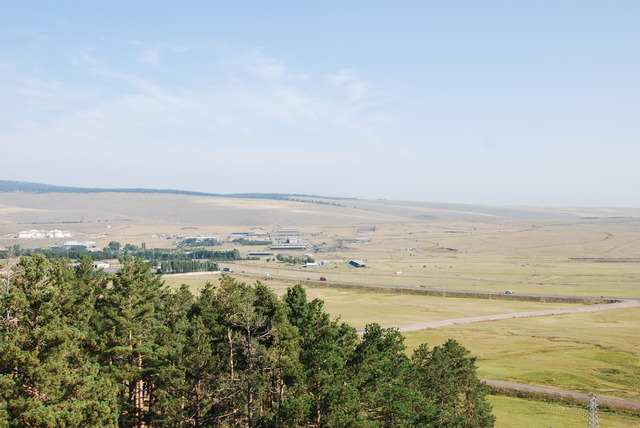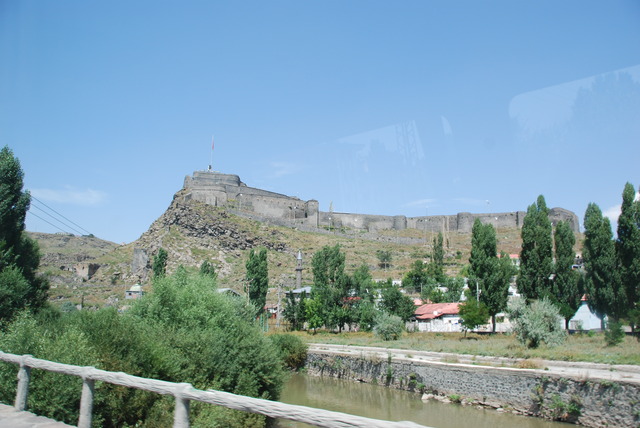On the morning of August 17th, everyone woke up early to see where we were. It had been pitch black darkness when we arrived late last night and we had no idea what the place looked like.
The Sarikamish Hotel was perched on a hill high above the main road. The view from the window was vast brown hills of farmland as far as the eye could see. Far in the distance below there were houses and perhaps villages.
There were pine trees close to the building giving it a ski lodge appearance. The morning air was cool. In the winter this is a major ski area with great amounts of snow. We ate breakfast with the Zironian family in the dining room and then prepared to leave Sarikamis.
 View of the Sarikamish Hotel from a distance
View of the Sarikamish Hotel from a distance
It was just a two hour drive to Kars, (rhymes with ‘farce’) which was our next destination. Selcuk expertly drove into the city of about 74,000 people. We noticed a distinct military or police presence in Kars. There were uniformed men with machine-guns posted every few blocks.
We arrived at the modern Grand Ani Hotel near the center of the city and checked in. One thousand years ago the Kars region was part of an Armenian kingdom. In the late 1890s, 21% of the population was still Armenian. Today, there are no known Armenians living in Kars. Orhan Pamuk’s novel, Snow, takes place in Kars.
Kars is a city in Northeastern Turkey and is the capital of Kars Province. The city is 5800 feet above sea level and winters are cold and snowy. Some sources claim that the name, Kars, is derived from the Armenian word, “harse” which means bride. Historic sites in the city are the Armenian Church of the Apostles (937 AD), a 15th Century Ottoman stone bridge, a 19th Century Russian cathedral, and the huge Citadel which dominates the city.
The walls of the Citadel date back to the Bagratid Armenian rule of 880-1045, but its present form was established in the 13th Century. The Turkish claim that it was built by the Ottomans in the 16th Century, but historians have proven that this is false. Kars was under Russian rule from 1878 through 1920, which accounts for the Russian style buildings in the city.
According to sources, the region produces some of Turkey’s best butter and honey, and thick rough wool carpets. Today most travellers go to Kars on their way to the ruins of Ani, the great medieval Armenian capital which is located 28 miles to the east, on the Turkish-Armenian frontier.
We were now a caravan of two bright white Mercedes ‘Sprinter’ vans. The Zironian Family in one van and our international cousins in the other. We drove through Kars and up a steep hill which was located in the center of town. Our hill looked across to the Kars Citadel on the next hill.
 Kars Citadel With Turkish Flag
Kars Citadel With Turkish Flag
We stopped at the top of the hill to see a huge cement monument dedicated to “peace” between the Armenians and the Turkish people. The unattractive cement monument is of two tall statues, men I suppose, facing each other. They are about to extend their hands to each other in a handshake, but there are no hands on either figure.
There was one very large cement hand on the ground and we all wondered out loud if or when the city, or the Turkish government, was planning to put hands on either statue to commemorate peace with a handshake.
The monument is on a high hill close to the center of the city of Kars. We all left the vans and walked around the top of the hill to admire the fantastic view and take photos. Several mosques could be seen below, as well as the former Armenian Church of the Apostles which was built in 930 A.D. It was converted to a mosque in 1579 and then converted into a Russian Orthodox church in the 1880s. It was converted back to a mosque in 1998.
Suddenly, as we stood there admiring the view, the “call to prayer” from the mosques in the valley began their chants. They sounded as if they were calling and responding to each other because the Imams had different pitched voices. It was quite an experience to hear the voices echo through the valley. High above them, we all stood silently listening to the chanting.
When the the “call to prayer” had stopped, we turned around to see Jemal walking around and eating a huge sandwich! Clearly, he was not celebrating Ramazan! It was about 1:00 PM and everyone was hungry for lunch but we had become accustomed to skipping lunches with Armen in charge. Jamal waved and called us to go to his van.
The back door was open and in the storage area he had placed large round loaves of ekmek (bread), strips of local cheese, peeled cucumber, and juicy long green peppers. He invited everyone to make their own sandwiches and we enthusiastically joined in. Bravo Jamal!
After our surprise picnic, we boarded the vans again and continued down the steep hill to visit the Church of the Apostles in the valley. A Turkish man with a religious cap stood in the doorway of the former church. He acknowledged our presence and with a serious expression, allowed us to enter the building. The architecture of the church was clearly Armenian church architecture and we carefully stepped over the threshold.
Later Satenik and I were walking around the outside of the church to admire the stone carvings on the outer walls. We saw a man standing with his hands open and extended sky-ward. He looked like he was praying. Muslim men usually pray with their hands at their side.
Satenik walked over to the man and began to speak to him in Turkish. He simply said that when he came to the former church he was inspired to pray outside and he chooses to pray in his own way. Later, Satenik said that she thought he or his family might have been Armenian, or perhaps Russian Orthodox, or Greek.
 A Mosque behind the Church of the Apostles
A Mosque behind the Church of the Apostles
Then we drove the short distance to Ani, the site of the ancient Armenian kingdom. To be continued…….










